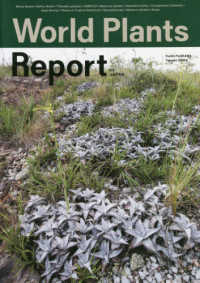- ホーム
- > 洋書
- > 英文書
- > Science / Mathematics
Full Description
For courses in Transition to Advanced Mathematics or Introduction to Proof.
Meticulously crafted, student-friendly text that helps build mathematical maturity
Mathematical Proofs: A Transition to Advanced Mathematics, 4th Edition introduces students to proof techniques, analyzing proofs, and writing proofs of their own that are not only mathematically correct but clearly written. Written in a student-friendly manner, it provides a solid introduction to such topics as relations, functions, and cardinalities of sets, as well as optional excursions into fields such as number theory, combinatorics, and calculus. The exercises receive consistent praise from users for their thoughtfulness and creativity. They help students progress from understanding and analyzing proofs and techniques to producing well-constructed proofs independently. This book is also an excellent reference for students to use in future courses when writing or reading proofs.
0134746759 / 9780134746753 Chartrand/Polimeni/Zhang, Mathematical Proofs: A Transition to Advanced Mathematics, 4/e
Contents
0. Communicating Mathematics
0.1 Learning Mathematics
0.2 What Others Have Said About Writing
0.3 Mathematical Writing
0.4 Using Symbols
0.5 Writing Mathematical Expressions
0.6 Common Words and Phrases in Mathematics
0.7 Some Closing Comments About Writing
1. Sets
1.1. Describing a Set
1.2. Subsets
1.3. Set Operations
1.4. Indexed Collections of Sets
1.5. Partitions of Sets
1.6. Cartesian Products of Sets
Chapter 1 Supplemental Exercises
2. Logic
2.1. Statements
2.2. The Negation of a Statement
2.3. The Disjunction and Conjunction of Statements
2.4. The Implication
2.5. More On Implications
2.6. The Biconditional
2.7. Tautologies and Contradictions
2.8. Logical Equivalence
2.9. Some Fundamental Properties of Logical Equivalence
2.10. Quantified Statements
2.11. Characterizations of Statements
Chapter 2 Supplemental Exercises
3. Direct Proof and Proof by Contrapositive
3.1. Trivial and Vacuous Proofs
3.2. Direct Proofs
3.3. Proof by Contrapositive
3.4. Proof by Cases
3.5. Proof Evaluations
Chapter 3 Supplemental Exercises
4. More on Direct Proof and Proof by Contrapositive
4.1. Proofs Involving Divisibility of Integers
4.2. Proofs Involving Congruence of Integers
4.3. Proofs Involving Real Numbers
4.4. Proofs Involving Sets
4.5. Fundamental Properties of Set Operations
4.6. Proofs Involving Cartesian Products of Sets
Chapter 4 Supplemental Exercises
5. Existence and Proof by Contradiction
5.1. Counterexamples
5.2. Proof by Contradiction
5.3. A Review of Three Proof Techniques
5.4. Existence Proofs
5.5. Disproving Existence Statements
Chapter 5 Supplemental Exercises
6. Mathematical Induction
6.1 The Principle of Mathematical Induction
6.2 A More General Principle of Mathematical Induction
6.3 Proof By Minimum Counterexample
6.4 The Strong Principle of Mathematical Induction
Chapter 6 Supplemental Exercises
7. Reviewing Proof Techniques
7.1 Reviewing Direct Proof and Proof by Contrapositive
7.2 Reviewing Proof by Contradiction and Existence Proofs
7.3 Reviewing Induction Proofs
7.4 Reviewing Evaluations of Proposed Proofs
Chapter 7 Supplemental Exercises
8. Prove or Disprove
8.1 Conjectures in Mathematics
8.2 Revisiting Quantified Statements
8.3 Testing Statements
Chapter 8 Supplemental Exercises
9. Equivalence Relations
9.1 Relations
9.2 Properties of Relations
9.3 Equivalence Relations
9.4 Properties of Equivalence Classes
9.5 Congruence Modulo n
9.6 The Integers Modulo n
Chapter 9 Supplemental Exercises
10. Functions
10.1 The Definition of Function
10.2 The Set of All Functions From A to B
10.3 One-to-one and Onto Functions
10.4 Bijective Functions
10.5 Composition of Functions
10.6 Inverse Functions
10.7 Permutations
Chapter 10 Supplemental Exercises
11. Cardinalities of Sets
11.1 Numerically Equivalent Sets
11.2 Denumerable Sets
11.3 Uncountable Sets
11.4 Comparing Cardinalities of Sets
11.5 The Schröder - Bernstein Theorem
Chapter 11 Supplemental Exercises
12. Proofs in Number Theory
12.1 Divisibility Properties of Integers
12.2 The Division Algorithm
12.3 Greatest Common Divisors
12.4 The Euclidean Algorithm
12.5 Relatively Prime Integers
12.6 The Fundamental Theorem of Arithmetic
12.7 Concepts Involving Sums of Divisors
Chapter 12 Supplemental Exercises
13. Proofs in Combinatorics
13.1 The Multiplication and Addition Principles
13.2 The Principle of Inclusion-Exclusion
13.3 The Pigeonhole Principle
13.4 Permutations and Combinations
13.5 The Pascal Triangle
13.6 The Binomial Theorem
13.7 Permutations and Combinations with Repetition
Chapter 13 Supplemental Exercises
14. Proofs in Calculus
14.1 Limits of Sequences
14.2 Infinite Series
14.3 Limits of Functions
14.4 Fundamental Properties of Limits of Functions
14.5 Continuity
14.6 Differentiability
Chapter 14 Supplemental Exercises
15. Proofs in Group Theory
15.1 Binary Operations
15.2 Groups
15.3 Permutation Groups
15.4 Fundamental Properties of Groups
15.5 Subgroups
15.6 Isomorphic Groups
Chapter 15 Supplemental Exercises
16. Proofs in Ring Theory (Online)
16.1 Rings
16.2 Elementary Properties of Rings
16.3 Subrings
16.4 Integral Domains
16.5 Fields
Chapter 16 Supplemental Exercises
17. Proofs in Linear Algebra (Online)
17.1 Properties of Vectors in 3-Space
17.2 Vector Spaces
17.3 Matrices
17.4 Some Properties of Vector Spaces
17.5 Subspaces
17.6 Spans of Vectors
17.7 Linear Dependence and Independence
17.8 Linear Transformations
17.9 Properties of Linear Transformations
Chapter 17 Supplemental Exercises
18. Proofs with Real and Complex Numbers (Online)
18.1 The Real Numbers as an Ordered Field
18.2 The Real Numbers and the Completeness Axiom
18.3 Open and Closed Sets of Real Numbers
18.4 Compact Sets of Real Numbers
18.5 Complex Numbers
18.6 De Moivre's Theorem and Euler's Formula
Chapter 18 Supplemental Exercises
19. Proofs in Topology (Online)
19.1 Metric Spaces
19.2 Open Sets in Metric Spaces
19.3 Continuity in Metric Spaces
19.4 Topological Spaces
19.5 Continuity in Topological Spaces
Chapter 19 Supplemental Exercises
Answers and Hints to Odd-Numbered Section Exercises
References
Index of Symbols
Index






